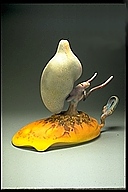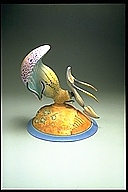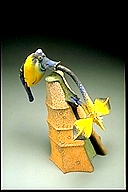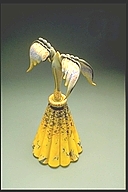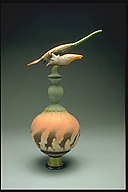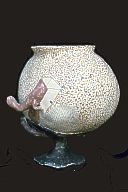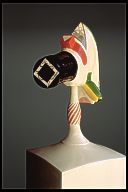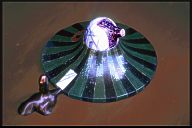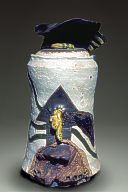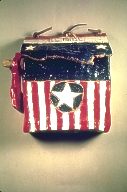Art site of Gary Molitor: Bay Area, California Sculpture, Art Ceramics, Art Cups, Drawings, Sci-Fi 3D Computer Art, Personal Life Stories, Sci-Fi Adventure Stories and Loads of Art Links.
Ceramic SculptureNew work is added to the top of this page.
To see an enlarged image of the thumbnail image, just click on it, wait and view.
|
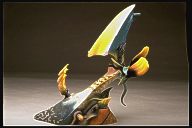 View 3D Stereographic Image #1 View 3D Stereographic Image #2 |
“Lau
(Longwalk) Tau”, 2000, 21"h - 20"w - 16"d. Cone 6 cast porcelain with underglaze colors and clear over glaze. Owned by Karen & Jeff Berttelson Lau Tau was not a Terrain but looked very Asian, tall and lanky, with an orange cast skin, mottled by puzzle shaped brownish marks and long flowing red hair. He earned the name "Longwalk" for having rescued his species' genome from the Mibbs. The Yartacs, as his species referred to themselves, had nearly been wiped in the war with the Mibbs. Without the genome code his race was doomed to extinction due to the complex genetic and religious system the Yartacs use for procreation. |
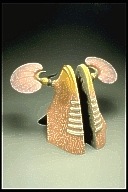 |
“Steps
above Galumýth”, 1989, 14"h - 12"w - 12"d. Cone 6 cast porcelain with underglaze colors and clear over glaze. The valley of Galumýth was where we, the Tasux Tæ Bazoüde, completed our final training. Above the valley rose Mount Orbin, crowned with a domed temple. It took us seven days of prayer and meditation to climb the "Steps" to the temple. It was there we received the sacrament and blessing from the Guides of Yaweht. Another view. |
|
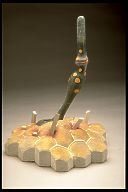 View 3D Stereographic Image |
“Far-out
Facets”,1980, 15"h - 16"w - 17"d. Cone 6 cast porcelain with underglaze colors, clear over glaze and refractory brick. After returning from Las Vegas, I felt like I had fallen into a hole. There was something definitely different about the way the world looked and how I felt. I felt somehow incomplete and I kept having these strange dreams. Actually the dreams were more alive than my awaking time. I found it hard to go to work. I just wanted to sleep. Some times I shared my dreams with Ross, my house mate. He liked the stories and suggested I see a dream counselor. In 1976 I started to see a dream therapist. he suggested that I explore some of the images from my dreams in clay. "Far-out Facets" is the only piece that came from this work. Between 1974 and 1984 I made one ceramic piece. |
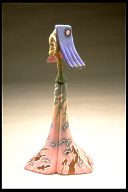 View 3D Stereographic Image |
“The
Angel of Victory”, 1976, 14"h - 8"w - 8"d. Cone 6 cast porcelain with underglaze colors and clear over glaze. Sold. In the collectionn of John Corbett The at Sonoma job ended with the return of "Muffy" Anderson. I went to Las Vegas to teach (that's a story for another page.) From Las Vegas I moved to Marin County. I setup a little studio in a 2 two car garage, sharing the space with an inflated rubber boat (Zodiac) that belonged to a professional skin diver and house mate. I did a few cups while there and this bottle. These were my first attempts at casting with porcelain. I really liked this way of working with clay. It is so involving; first the idea, a clay model, mold making, careful firing and glazing with control. I first started casing clay when an old friend, Steve Samuel, who had asked me to make a mold of a steel drum called a "Dumbec". These drums vary in size, look like the combustion chamber of a rocket motor and make this great resonate DOOUNG sound. I still have one. Before this piece, I did a series of stoppered bottles, one which can be seen below. Low fire white clay just looks too soft and artificial, porcelain is hard and the color is fired right in to the surface. |
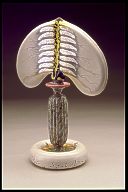 View 3D Stereographic Image |
“She
Smells So Good,” 1970, 14"h - 11"w - 6"d. Cone 05 white ware, underglaze, clear over glaze, china paints and lusters. Sold. In the collectionn of John Corbett After moving to Novato, CA, I got a full time replacement teaching job at Sonoma State College. The Vietnam War was really hot and all the fine young white boys were doing all they could to keep their draft deferment. We had art students lining up by the hundreds. Today art classes are empty and college administrators are cutting art faculties in all but a few colleges and universities nation wide. I had some really great students then; Jeff Mann, a model wizard at ILM and Scott Chamberlin, a ceramic sculptor and professor of art at the University of Colorado. Sonoma State is were I met Steve Dubov, who has become a life long friend. |
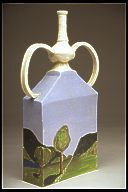 |
“Before
880”, 1967, 13"h - 8"w - 3"d. Cone 05 white ware, underglaze, clear over glaze. Personal collection. After I finished the work for the Dilexi show, I finished this bottle, a series of small cups and the large goblet shown below. |
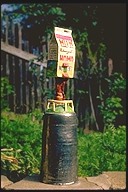 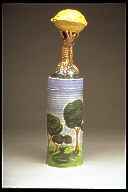 |
“Tree
Farm Milk” & “Nut Tree,” 1968, 15"h - 6"w - 6"d. Cone 05 white ware, underglaze, clear over glaze, china paints and lusters. Owned By Richard Beggs Between '64 and '68 I wasn't doing a lot of clay as I was focused on non-clay sculpture. While teaching at University of California at Davis, I couldn't help but be influenced by Robert Arneson (the Farther of West Coast Funk Ceramics), Richard Shaw (doing these great hand thrown cows) and Chris Unterseher (with his wonderful miniature dioramas). Bob stopped using stoneware clay in TB9. He moved to low temperature white clay for his own work and as a material for teaching. While teaching there I tried throwing some cylinders with it. The jars to the left are a takeoff on the "tree" restaurant theme. In 1968, between San Francisco and Davis, just over the hills east of Benica and along highway 80, were a series of restaurants, starting with the "Nut Tree" then came the "Coffee Tree", "Stuckies" and the "Milk Farm". I did a series of 3 jars using a tree trunk as part of the top of the lid. In all honesty, this work was more of a steal of the Davis atheistic than a real outgrowth of my own atheistic. In 1969 the Cal. University system took a heavy budget cut at the hands of then governor Reagan and I lost my job. I had been given verbal approval for a position in Reno but when I reported for class assignment, the job had been given to someone else. A sad lesson in art politics. That summer Joan and I traveled through Canada which lead me to a National Park ranger job at the Chiricahua National Monument, AZ. Then another budget cut and a move to Lompoc, CA. |
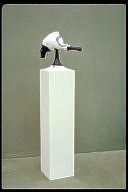 |
“Void Where Prohibited by Law, #1 ,” 1965, 16"h
- 13"w - 9"d. Stoneware glazed clay, polyester filler, wood, enamel paint. This work was part of my graduate thesis. I built four of these totems. The box like base was made from plywood and the horn shape was "Bondoed" on to the box and the organic shape placed on the small end of the horn. This basic concept has been the underling format for most of my clay work. From an aesthetic point, the contrast between extremes has always been attractive to me. Or as we learned in our critique classes "the didactic play between the formal elegance of one form playing against the organic vitality of another form." It has been the juxtaposition of these two contrasting elements that has dominated my clay work.
#2 of 4 from this series. |
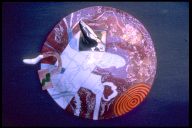 |
“Rise
of the Slime Molds #3 and #4” 1964, 2"h - 13"w - 9"d. Porcelain with underglaze pencil drawing and china paint over glaze. #3, Owned by Jerold Walberg, Sacramento, CA #4, Buried at 80 Canyon, San Anselmo, CA. This work was part of my masters thesis. There were six shapes that represented the stages for development between morphogenisis and fruiting body of Slime Mold. In my microbiology classes I was very fascinated by a class of myxomycetes that reproduced in a very interesting way. Using the the potters wheel, I made the shapes in clay. From the clay I made plaster molds. I pressed porcelain clay in to the molds to make the shapes. Later I used these same molds to made some of the fiberglass shapes for the Dilexi show.
|
||
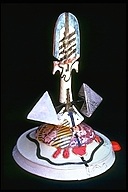 |
“For
Wolves and Old Ladies, #5,” 1964, 65"h - 17"w - 12"d. Stoneware glazed and fired to cone 05 with lusters and china paints. Owned by Mel Henderson In my first graduate year I saw two shows that had a profound effect on the direction of my work. The first was a group show at the San Francisco Art Institute, where Ron Nagle had some of his latest work and the other was a small show of Jim Melchert porcelain masks at Wanda Hanson's "Downstairs Gallery" in a little San Francisco alley call Tillman Place. One of Ron's that really made me look at clay in a new way was a very large stoppered perfumed bottle with large handles titled, if I recall correctly, "Talbot" (inspired by Lon Chenny Jr. as the wolfman). Jim Melchert did a series of small hand built porcelain mask like heads. I had never seen white clay handled like that. The piece to the left is an outgrowth of those experiences. This is a stoppered bottle idea. I made it in stoneware clay because it is easy and forgiving for hand building. Then I applied a white slip, bisqued fired it, applied a commercial clear glaze, fired it to cone 05 and colored the surface with metallic luster and china paints which were fried to cone 018. When Bud McKee (my graduate adviser) saw this work, he had a fit. We got into a big argument about plagiarism. I got pissed off, change my graduate emphasis to sculpture (because that was the direction I was going in any way) and change advisors. Mel Henderson was less confrontational and more directional. He would point out things I hadn't seen or ideas that were barely within my sight.
|
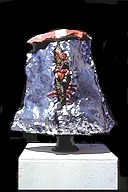 |
“Holly
of Whole Lilies”, 1962, 16"h - 13"w - 9"d. Stoneware, Cone 10 fired glazed and spray painted with automotive alkyd enamels. Lost or destroyed This is my first painted pot using non-ceramic carbon based coating. Although this looks like a container it is totally nonfunctional. This piece was done on a whim. I felt that there was too much dogma being taught in the ceramics in Northern Cal. I did this piece as a protest against "pottery." No one ever used paint on clay. One HAD to maintain "integrity of the material ... one can only use glaze to color the surface. BS. I wanted my work to stand as sculpture. It was my first real attempt at "content art" – making a statement. I tried to capture my feelings (undefined impressions) about my relationship to women. Being 21 and sex-starved, thinking of women in any terms other than sexual was near impossible. For me they were:.. soft, "Iron Maidens", attainable, shielded, madonnas, Joan of Arks . Would my desire consume me, are sharp teeth waiting in the sacred sexual sacrament? After 40 years the answer is in ... |
Ceramic Sculpture Sculpture 2D Images Event Based Conceptual Works Digital Sculpture
Art Cups Photography Stereographic Gallery Stereographic Ceramics HOME
Thoughts on Knowing Nothing Utility Knife Gallery The Mind Factory Goodbye!
Art site of Gary Molitor: Bay Area Art History, California
Site designed and executed by G.W. Molitor. All rights reserved
Copyright © 1997, — 2014; Gary W. Molitor. San Leandro, CA
Send mail to gary.molitor@gmail.com with questions or comments about this web site.
Please note that the links offered here are not for commercial purpose but for your information only.
Updated 06/06/2014.
